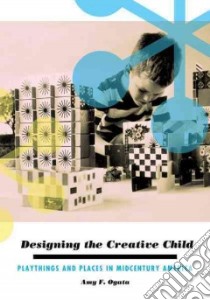Designing the Creative Child - 9780816679614
Un libro in lingua di Ogata Amy F. edito da Univ of Minnesota Pr, 2013
- € 31.20
- Il prezzo è variabile in funzione del cambio della valuta d’origine
The postwar American stereotypes of suburban sameness, traditional gender roles, and educational conservatism have masked an alternate self-image tailor-made for the Cold War. The creative child, an idealized future citizen, was the darling of baby boom parents, psychologists, marketers, and designers who saw in the next generation promise that appeared to answer the most pressing worries of the age.
Designing the Creative Child reveals how a postwar cult of childhood creativity developed and continues to this day. Exploring how the idea of children as imaginative and naturally creative was constructed, disseminated, and consumed in the United States after World War II, Amy F. Ogata argues that educational toys, playgrounds, small middle-class houses, new schools, and children’s museums were designed to cultivate imagination in a growing cohort of baby boom children. Enthusiasm for encouraging creativity in children countered Cold War fears of failing competitiveness and the postwar critique of social conformity, making creativity an emblem of national revitalization.
Ogata describes how a historically rooted belief in children’s capacity for independent thinking was transformed from an elite concern of the interwar years to a fully consumable and aspirational ideal that persists today. From building blocks to Gumby, playhouses to Playskool trains, Creative Playthings to the Eames House of Cards, Crayola fingerpaint to children’s museums, material goods and spaces shaped a popular understanding of creativity, and Designing the Creative Child demonstrates how this notion has been woven into the fabric of American culture.
Informazioni bibliografiche
- Titolo del Libro in lingua: Designing the Creative Child
- Sottotitolo: Playthings and Places in Midcentury America
- Lingua: English
- Autore: Ogata Amy F.
- Editore: Univ of Minnesota Pr
- Collana: Univ of Minnesota Pr (Paperback)
- Data di Pubblicazione: 21 Aprile '13
- Genere: HISTORY
- Pagine: 293
- Dimensioni mm: 254 x 177 x 38
- EAN-13: 9780816679614


